|
|
General: IGLESIA DE LA MADELEINE(TEMPLO CATOLICO)-PARIS/FRANCIA
Choisir un autre rubrique de messages |
|
Réponse |
Message 1 de 21 de ce thème |
|
Iglesia de la Madeleine
La iglesia de la Madeleine es un templo católico de estilo neoclásico1 situado en París (Francia), cerca de la plaza de la Concordia, en una importante zona comercial (al lado de la calle Faubourg-Saint-Honoré, una de las más prestigiosas de París). La iglesia de la Madeleine llama la atención por su arquitectura en forma de templo romano, inspirado en la Maison Carrée de Nimes.
La construcción comenzó aproximadamente en 1764 por Pierre Contant d'Ivry, aunque con su fallecimiento, será reconstruida con planos de Guillaume Couture (1777).2 A causa de la Revolución francesa las obras se interrumpieron de 1790 a 1805. En 1806, y por decisión del emperador Napoleón Bonaparte, La Madeleine se transformó radicalmente, desechando la mayor parte de lo ya construido, y entre 1807 y 1828 Pierre Alexandre Vignon2 lo levantó prácticamente de nueva traza, especialmente determinada por el aspecto exterior (templo períptero octástilo de orden corintio). No se destinaría a iglesia católica, sino para Templo a la Gloria de la Grande Armée ('Gran Ejército'), uso cívico que mantuvo hasta que se acabó de construir el Arco del Triunfo, que la relevó en esa función.
En 1833, Henri Lemaire comienza las esculturas del El juicio final en el frontón.2 Entre 1835 y 1837, Jules-Claude Ziegler pinta la L'Histoire du christianisme en el ábside,2 y entre 1835 y 1857, el escultor italiano afincado en París, Marochetti, talla la gran estatua de María Magdalena para el altar.2
En 1841, se instalan las puertas de bronce diseñadas por Henri de Triqueti y en 1842 fue inaugurado como iglesia católica por el arzobispo de París. En 1846, se instala el gran órgano construido por Aristide Cavaillé-Coll.
El interior de la Madeleine está proyectado en estilo barroco, lo que crea un contraste entre las fachadas y la parte interna de la iglesia. Destacan las vistas desde la parte superior de la escalinata en donde se contempla la Rue Royal, con la plaza de la Concordia y el Obelisco de Luxor en el centro.
La iglesia ha tenido varios destacados músicos y compositores que han ocupado el cargo de organista de la iglesia, entre ellos Camille Saint-Saëns –el segundo organista en ocupar el puesto–, entre 1858 y 1877, Théodore Dubois –entre 1877 y 1896–, y
|
|
|
|
Réponse |
Message 7 de 21 de ce thème |
|

Cathedral of the Madeleine
From Wikipedia, the free encyclopedia
The Cathedral of the Madeleine is a Roman Catholic church in Salt Lake City, Utah, United States. It was completed in 1909 and currently serves as the cathedral, or mother church, of the Diocese of Salt Lake City. It is the only cathedral in the U.S. under the patronage of St. Mary Magdalene.
Description[edit]
The cathedral was built under the direction of Lawrence Scanlan, the first bishop of Salt Lake City, who dedicated it to St. Mary Magdalene.[2] It was designed by architects Carl M. Neuhausen and Bernard O. Mecklenburg. The exterior is predominantly a Neo-Romanesque design, while the inside displays more Neo-Gothic details. Construction began in 1900 and was completed in 1909. It was dedicated by James Cardinal Gibbons, Archbishop of Baltimore.
It is theorized that Bishop Scanlan chose Mary Magdalene as the patron saint of the Diocese of Salt Lake because her feast day is on July 22, two days before Pioneer Day, a celebration commemorating the arrival of the Mormon pioneers in Salt Lake Valley, so that Catholics would have something to celebrate alongside the region's dominant faith.[3]
The interior of the cathedral was created under the direction of Joseph S. Glass, the second bishop of Salt Lake. Bishop Glass enlisted John Theodore Comes, one of the preeminent architects in the country, to decorate the interior of the cathedral. His plans for the interior were largely based upon the Spanish Gothic style. The colorful murals and polychrome were added at this time, as were the ornate shrines. In 1916, Bishop Glass also changed the name of the cathedral to the French spelling after visiting her purported tomb.[2]
In the 1970s, the exterior of the building was restored, and between 1991 and 1993, the interior of the cathedral was renovated and restored under Bishop William K. Weigand. This included not only the removal of dust and dirt and restoration of the interior but also changes to the liturgical elements of the cathedral to bring them into conformity with certain widespread changes in liturgical practice that developed after the Second Vatican Council.
This included constructing a new altar, moving the cathedra, creating a separate chapel for the Blessed Sacrament, and adding an ample baptismal font. The Blessed Sacrament Chapel also contains the tomb of Bishop Scanlan.[4] Resting atop the tomb is a case containing a small relic of Saint Mary Magdalene. The cathedral in Salt Lake City and the Basilica of Saint-Maximin-la-Sainte-Baume in France are the only cathedrals in the world holding first-class relics of the saint and are named in her honor.[5] The major restoration of the interior of the cathedral was accomplished through the vision of Monsignor M. Francis Mannion.[6]
The cathedral is home to the only co-educational Catholic Choir School in the United States. The Madeleine Choir School, established in 1996, now serves over 400 students in Pre-Kindergarten through Grade Eight.[7] The Cathedral Choir has recorded several CDs and routinely tours both nationally and internationally. In addition to singing daily services at the Cathedral of the Madeleine, choristers have sung at St. Peter's Basilica (Vatican City), Notre Dame de Paris (France), and in churches across the United States of America, Spain, Italy, France, Belgium, and Germany, among other places.[8]
Composer Amédée Tremblay notably served as the church's organist from 1920 to 1925.[9]
-
-
Cathedral of the Madeleine, looking east
-
Interior of the cathedral
-
   |
|
|
|
Réponse |
Message 8 de 21 de ce thème |
|
|
|
|
Réponse |
Message 9 de 21 de ce thème |
|
|
|
|
Réponse |
Message 10 de 21 de ce thème |
|
|
|
|
Réponse |
Message 11 de 21 de ce thème |
|
|
|
|
Réponse |
Message 12 de 21 de ce thème |
|
|
|
|
Réponse |
Message 13 de 21 de ce thème |
|
|
|
|
Réponse |
Message 14 de 21 de ce thème |
|
|
|
|
Réponse |
Message 15 de 21 de ce thème |
|
|
|
|
Réponse |
Message 16 de 21 de ce thème |
|
|
|
|
Réponse |
Message 17 de 21 de ce thème |
|
| Enviado: 21/10/2024 10:30 |
|
|
|
|
|
|
Réponse |
Message 18 de 21 de ce thème |
|
|
|
|
Réponse |
Message 19 de 21 de ce thème |
|
La Madeleine

Foto: joz
Para ser una iglesia, la Madeleine tiene sin duda una forma extraña, pues parece más bien un templo de la antigua Roma. La explicación hay que buscarla en la turbulenta historia de París en los años que rodean a la Revolución Francesa.
Historia del monumento

La antigua Madeleine
Antes de que esta zona de la ciudad quedara completamente alterada con la construcción de la enorme Plaza de la Concordia, existía en este lugar una pequeña iglesia de la Madeleine. Pero el diseño de la nueva plaza exigía una iglesia más grande, cerrando la perspectiva de la "Calle Real", que conducía hasta ella.
Cuando estalló la Revolución Francesa, la iglesia se encontraba todavía a medio construir, e inmediatamente se detuvieron las obras.
Pasado el periodo revolucionario, Napoleón quiso convertir la iglesia inacabada en un templo pagano, dedicado a la gloria del Gran Ejército, la Grande Armée. Para ello, derribó todo lo construido hasta entonces, y comenzó a levantarse el edificio que hoy contemplamos.
Pero finalmente, viendo que su efímero Imperio se derrumbaba, decidió que el edificio, ya muy avanzado, volviera a su uso original como iglesia.
Exterior del monumento
La Madeleine tiene la forma de un templo "periptero", es decir, rodeado de columnas por sus cuatro costados, como los templos griegos. Y posee las mismas dimensiones que el mayor templo de la antigua Grecia: el de Zeus Olímpico de Atenas.
Los elementos más destacados en el exterior de La Madeleine son:
1. El frontón
Fue construido después de la Restauración borbónica, en tiempos de Luis Felipe de Orleans, el "rey ciudadano". Aunque Luis Felipe había sido partidario de la Revolución, quiso que la imagen de este gran frontón tuviera un espíritu de conciliación. Por eso permitió que apareciera en él María Magdalena arrodillada ante Jesucristo Juez, como una alegoría de la Francia arrepentida, que suplica perdón por la ejecución de Luis XVI.
En efecto, a pocos pasos de esta iglesia, en la Plaza de la Concordia, había tenido lugar, el 21 de enero de 1792, la muerte del rey en la guillotina.
2. Puertas de bronce
Las puertas de entrada al templo son uno de los elementos más impresionantes de esta iglesia, por sus colosales dimensiones y por la fuerza de sus relieves.
Fueron realizadas por el barón Henri de Triqueti y representan "Los diez mandamientos". Los dos primeros se encuentran en el panel horizontal de la parte superior, y los otros 8 en las hojas de las puertas.
Estos son los mandamientos, y las escenas que los representan. Todas ellas están tomadas del Antiguo Testamento y tienen gran fuerza expresiva.
- "No tendrás otros dioses fuera de mí". Escena que lo ilustra: el pueblo judío recibe las tablas de la Ley.
- "No invocarás en vano el nombre de Dios". El pueblo judío ante Moisés.
- "Santificarás las fiestas". Dios descansa el séptimo día.
- "Honra a tu padre y a tu madre". Noé maldice al hizo que se burló de él.
- "No matarás". Caín es castigado por la muerte de su hermano.
- "No cometerás adulterio". El profeta Natán recrimina al rey David.
- "No robarás". Josué dictando sentencia por un robo.
- "No levantarás falso testimonio". Daniel defiende a la casta Susana ante la acusación injusta.
- "No codiciarás la mujer de tu prójimo". Dios rescata a Sara, la mujer de Abraham.
- "No codiciarás la casa de tu prójimo". Elías recrimina al rey Acab por codiciar la viña de Nabot, y darle muerte.

Detalle del 5º mandamiento. Abel yace en tierra tras ser asesinado por Caín. Foto: joz
Visita al interior
Si el exterior de La Madeleine parece un templo pagano de la Antigüedad, el interior se organiza como unas termas, con gran profusión de mármoles de colores.
Su mayor defecto es la escasa luz natural, que deja a la iglesia habitualmente en semipenumbra.
El techo se cierra mediante bóvedas rebajadas, adornadas con casetones y con un gran óculo en el centro, inspiradas en el Panteón de Roma.

Foto: Guilhem Vellut (recorte)
La iglesia está llena de esculturas realizadas por artistas que fueron los mejores en su momento. El gobierno de Luis Felipe de Orleans puso gran cuidado la decoración de esta iglesia, que debía ser "El Remplo de la Reconciliación nacional", tras las convulsiones de la Revolución Francesa y del Imperio. Por eso destinó a La Madeleine grandes cantidades de recursos.
Las piezas más vistosas son:
- El gran grupo escultórico sobre el altar principal, obra de Charles Marochetti. Se llama "El arrebato de María Magdalena", a la que muestra en éxtasis, en el momento de ser arrebatada al cielo, transportada en una canastilla por ángeles de enormes alas.
-
El enorme fresco de Jules-Claude Ziegler, en el casquete del ábside. En él aparecen representados personajes de la Iglesia, de todas las épocas y culturas. La escena central representa a Cristo, que acoge y perdona a María Magdalena (alegoría de Francia arrepentida, como en el relieve del frontón).
Una banda a los pies de la santa explica el motivo: dilexit multum, amó mucho.
En el fresco aparece también la figura de Napoleón Bonaparte, que en ese momento acababa de fallecer y era extraordinariamente popular en Francia. Clica en la imagen para verlo.
LINKS ÚTILES
|
|
|
|
Réponse |
Message 20 de 21 de ce thème |
|
|
|
|
Réponse |
Message 21 de 21 de ce thème |
|
According to Pythagoras an entity is called a number when the product of itself is greater than the sum of itself. One is not a number, according to the above definition, it is god, generator of numbers. Two is also not a number, because both the product and the sum are equal to each other, that is, it is a coexisting god, a second generator of numbers. The numbers start with three because 3 X 3 = 9 an

The Tetraktys is the Essence of Teaching and the Sacred Symbol of the Pythagoreans. It consists of the first ten numbers (1-10) arranged in four rows (one in the first row, two in the second, three in the third and four in the fourth row) as shown in the picture. Tetraktyn was called “Tetradas”[1] which in Pythagorean Philosophy is the essence and meaning of the number four. Tetraktys is the fourth “triangular number”[2] thus showing another view of the relationship of Tetrad and Tetraktyos. In any case, we should not forget the relation of Tetraktys with “Ten”. From this the Tetraktys is mentioned according to Iamblichus with the prepositional names: Cosmos (decoration, ornament), Pan (the god Panas – Pan = All), Uranus, Atlas, Key, Aion, Memory, Gnomon, Eimarmene, Kratos, Phanis, Helios, Pythmen et al. By studying the concepts of numbers found in the Tetractyn and their relationships, the Pythagoreans argue that one reaches the attainment of wisdom.
The main relationship of Tetrad and Tetraktyos can also be seen from the famous relationship of the first four numbers with the ten they produce when added (1+2+3+4=10). From these first four numbers (1, 2, 3 & 4), it is possible to construct the ratios: “by four” (4:3, fourth), “by five” (3:2, fifth), “by all ” (2:1, Octave), which attribute to music the mentioned harmonic musical intervals which Pythagoras was the first to precisely determine with numerical reasons. These proportions create Harmony, which for the Pythagoreans has a literally cosmic meaning (hence its name “Cosmos”). The Pythagoreans used the Tetraktyn to swear, even invoking Pythagoras as a god, as can be seen from the “Golden Epics” where it is stated:
“Yes, with the immortal soul, delivered four times
always of a permanent nature.”
(yes, but the one who delivered to our soul the tetractyn,
which is the source of eternal nature.)
Numbers are related to geometric shapes. Thus the unit is related to the point, the dyad to the line, the triad to the triangle, and the tetrad or tetraktys to the tetrahedron (or triangular pyramid), the first geometric solid. Its symbol was considered the square which was also the symbol of the divine and perfection.[5]. Also wisdom was considered to be acquired from the four esoteric sciences for the Pythagoreans of arithmetic, music, geometry and astronomy. It is a symbol of God Apollo and the Pythagoreans connect the Tetraktyn with the Oracle of Delphi, as seen in the important “hearing” about existence mentioned by Iamblichus[6]: “what is the Oracle in Delphi? Tetraktys” (what is the Oracle of Delphi? Tetraktys).
There is another Tetraktys, as mentioned in Plato’s Timaeus, which is called a double Tetraktys and consists of eight lines created by the first eight numbers (1, 2, 3, 4, 5, 6, 7, which in total give a total of 36 (1+2+3+4+5+6+7+8=36). From another point of view this Quadrilateral is created, and thus connected to the regular Quadrilateral Quadrilateral, by the sum of the first four odd numbers and of the first four integers: (1+3+5+7)+(2+4+6+8)=36 as mentioned by Plutarch in “On Isis and Osiris”.

GOLDEN RATIO Φ ON THE PYTHAGORIAN SYMBOL
PARTHENON WAS BUILT on the PRNICIPLES of PYTHAGORAS
 
The FIRST FLYING MASCHINE was BUILT by the GREEK PYTHAGOEIAN PHILOSOPHER ARCHYTAS in TARANTO(CORINTHIAN COLONY) SOUTHERN ITALY.
For the Pythagoreans, a politician was the person who, after having been taught philosophy, returned to the world to be useful to others.
He is not interested in positions and powers but in the improvement of society.
The one who chose to become a politician could not pass to the stage of a mathematician, that is, one who can deliver lessons and teach.
Those who could had the advantage of living near Pythagoras.
Friendship and companionship were of the highest importance for the Pythagoreans and they considered that universal love was reflected in these two elements.
They were bound by an oath of secrecy over the higher teaching, the ceremonies and the sacred symbols.
Pythagoras offered mankind a universal “successful experiment” for this and later Plato would call education with music and gymnastics!!!!

ONE OF THE BASIC PYTHAGORIAN GROUNDS FOR: ARCHITECTURE, GEOMETRY, MUSIC, STEREOMETRY, ASTRONOMY, HARMONY AND PHILOSOPPHY

WHAT DID PYTHAGORAS SAYABOUT WOMAN=ΓΥΝΗ/GYNE
https://euphoriatric.com/pythagoras-the-nine-muses/ |
|
|
 Premier Premier
 Précédent
7 a 21 de 21
Suivant Précédent
7 a 21 de 21
Suivant
 Dernier
Dernier

|
|
| |
|
|
©2025 - Gabitos - Tous droits réservés | |
|
|

